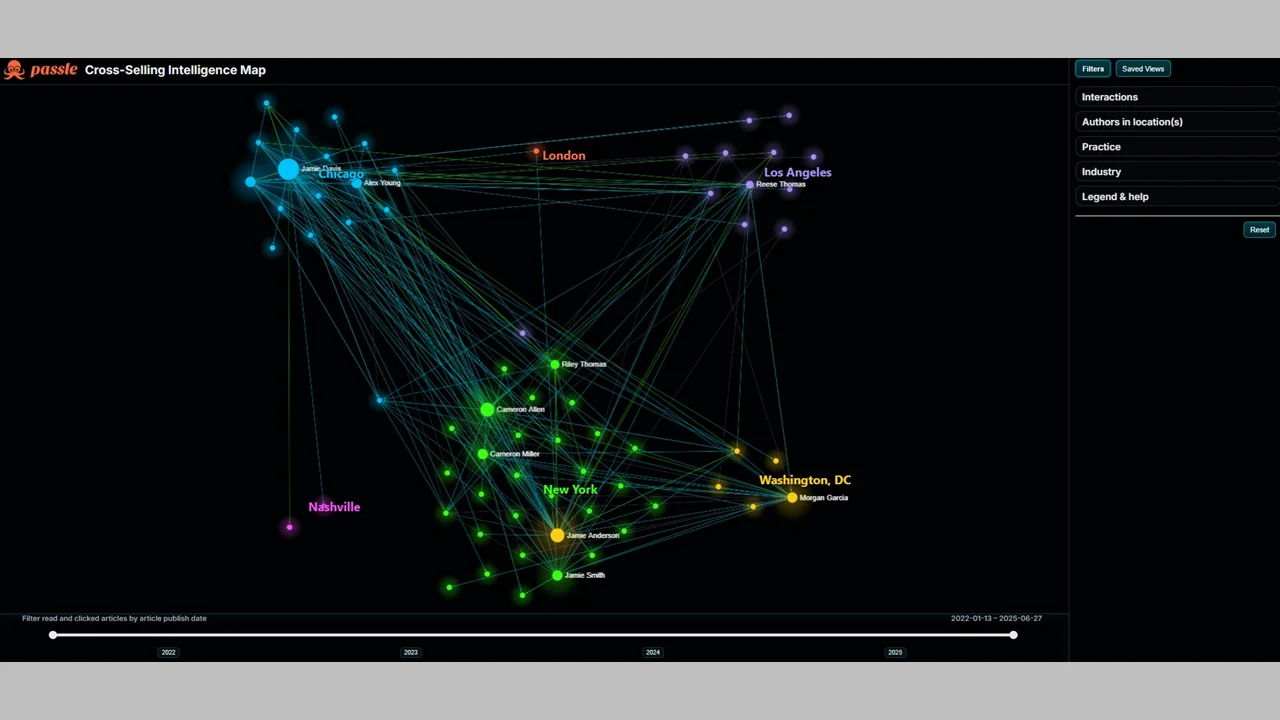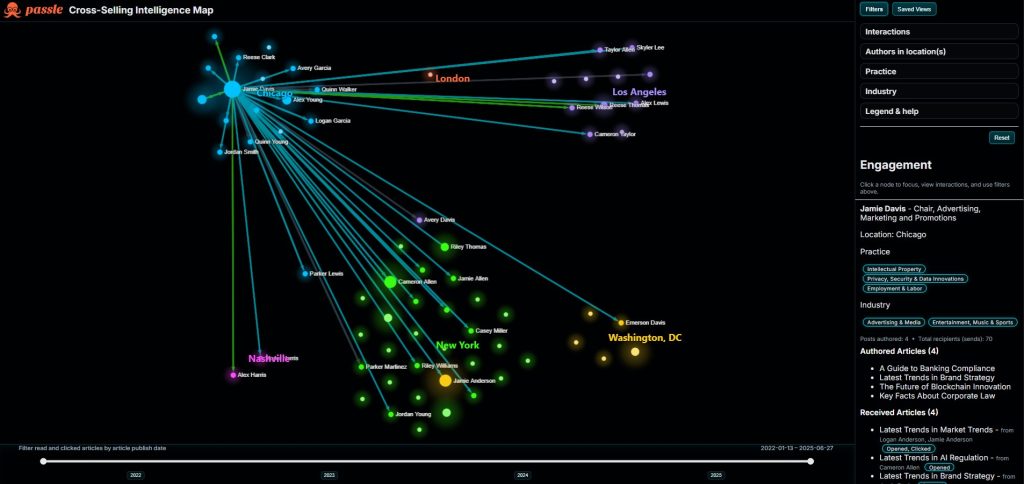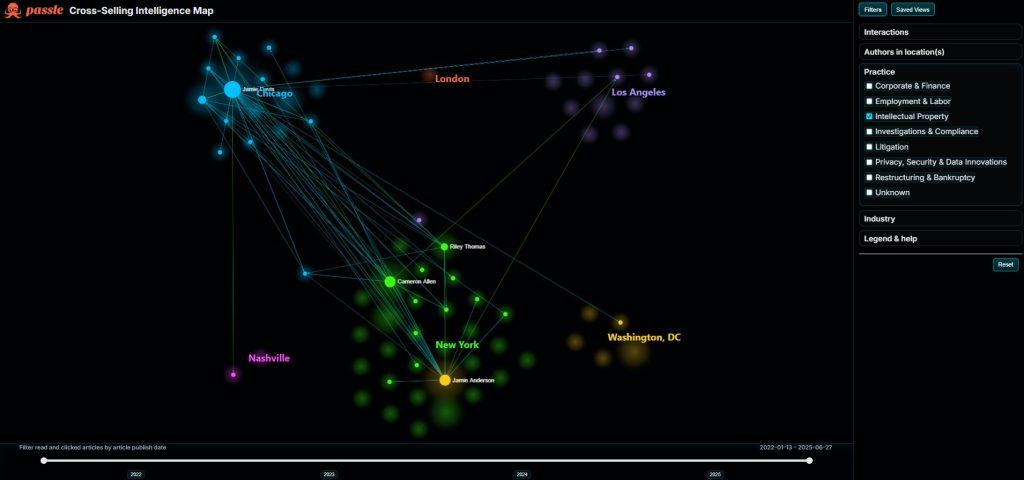Exclusive: Passle Launches Intelligence Map to Visualize Cross-Selling Activity Within a Law Firm

Passa technology company that develops thought leadership and cross-selling tools for law firms, has unveiled a new visualization tool for its CrossPitch AI platform that promises to make cross-selling activity in law firms visible, actionable and measurable for the first time.
The Cross-Selling Intelligence Map, released today, creates a network diagram showing how thought leadership content flows among a firm’s lawyers across different offices and practice areas.
The Intelligence Map aims to address what Passle calls a major revenue leak: 84% of law firm business development and marketing professionals believe their firms are missing out on cross-selling opportunities, and 99% believe it costs them at least 10% of their annual revenue, according to a study commissioned by Passle.
AI to boost cross-selling
The map is an extension of the company’s CrossPitch AI, which launched in June and uses artificial intelligence to analyze thought leadership content written by attorneys, such as blog posts, articles and client alerts. Using attorneys’ public biographical information, the system automatically identifies colleagues who may have clients interested in this content and sends them personalized email notifications with AI-generated summaries.
“The AI reads the thought leadership that has been created at the firm and it reads the bio pages, the profile pages of all the lawyers in the firm and it puts the two together,” explained James Barclay, CEO of Passle, in an interview with LawSites last week.
Notifications include an 80-100 word summary so attorneys can quickly understand the relevance of the content without reading the entire article.
To complement what the AI gleans from their public bio, lawyers can add an “enhanced profile” in Passle where they specify topics of interest in natural language – like “all things pharmaceutical” or “artificial intelligence.”
A firm’s business development teams can set a relevance threshold (typically 70 to 75 percent, according to Barclay) to control the number of notifications lawyers receive, balancing comprehensiveness and information overload.
The platform also generates pre-written “I saw this and thought of you” emails that lawyers can send to clients with one click, simply requiring that they add a personal welcome message.
Visualize the invisible
Building on this Crosspitch AI platform, the new Intelligence Map launched today transforms this notification data into an interactive network visualization.
The map can be filtered to show activity for a specific office.
Larger dots represent more active attorneys who create and share more content. The connections between the dots show where thought leadership is shared within the company. Light and dark spots reveal areas of high and low activity.
Users can filter the map by location, practice area, or industry, and use a timeline slider to track changes over time. This gives leaders access to insights such as whether a lateral hire or newly acquired practice group fits into the company’s knowledge sharing ecosystem or remains isolated.
In his conversations with large law firms, Barclay said, they always want to know how they can demonstrate collaboration between attorneys and practice groups, particularly following a merger or acquisition.
This map, he says, allows them to do just that, visually.
The cross-selling challenge
The map addresses two fundamental barriers to cross-selling that Barclay regularly sees in businesses: awareness and trust.
“We don’t know what our colleagues know, and we need to know,” Barclay said. As one managing partner told him: “I kind of knew what the people on my floor knew. I didn’t really know what the people upstairs or downstairs knew. And I certainly didn’t know what Los Angeles or London was talking about.”

The map can show the activity and engagement of a specific lawyer.
The barrier of trust is just as important. “I just spent 15 years building a book of cases and I don’t know if I want to introduce Jenny, who I haven’t heard of, to my client,” Barclay said, describing how this trust issue could prevent lawyers from cross-selling.
By repeatedly exposing lawyers to their colleagues’ expertise through relevant content summaries, the platform aims to build both familiarity and trust.
He described a lawyer, Alice, receiving alerts about her partner Oscar’s articles on autonomous vehicles. The first time she receives it, she will barely notice it. The second time, she might think, “Oh, that’s interesting, Oscar always writes about autonomous vehicles. That’s pretty cool.” The third time she might realize she wants to contact Oscar.
Eliminate the guesswork
Since its launch in June, CrossPitch AI has been adopted by 29 law firms, including Barnes & Thornburg, Loeb & Loeb, Manatt, and firms in the Am Law 200 and UK Top 50. Passle reports that open rates for CrossPitch notifications average 42%, more than double the industry average of 18% for legal marketing emails.
“With CrossPitch AI, we’ve taken the guesswork out of the equation and replaced it with a data-driven roadmap showing where our insights will have the greatest impact,” Trish Lilley, director of marketing and business development at Barnes & Thornburg, said in a statement provided by Passle. “This fact-based approach allows us to deliver optimal value to our customers by bringing the right people together faster. »

Activity can be filtered by practice areas.
Notably, CrossPitch AI only analyzes publicly available information, such as published thought leaders and public attorney biographies, to avoid any concerns law firms may have about providing an AI tool with access to confidential client data or internal firm documents.
“Salespeople like us come in and say, hey, we have a silver bullet…and all we have to do is look at all your top secret stuff and learn it and read it and don’t worry, everything will be fine,” Barclay said.
Passle deliberately took a different approach, using only publicly available content sources.
Not only does this allay companies’ fears of exposing their data, but it also allows them to implement the product much faster – in just a week, Barclay said.
The AI platform can work with any content source and does not require businesses to use Passle’s separate thought leadership platform.
Integration of lateral hires
Beyond general cross-selling, Intelligence Map specifically targets onboarding lateral hires – a persistent challenge given that around 50% of lateral hires leave within five years, according to some industry estimates.
For a lateral that cost anywhere from $750,000 to several million dollars to hire, the map can show managing partners and business development teams whether that lawyer is making themselves known throughout the firm by creating and sharing their expertise – or remaining disconnected from potential cross-selling relationships.
“The reason you’re here,” Barclay said of lateral hires, “is basically to cross-sell. You build your book, you bring your book and you make sure that other people know that you’re here and that we can sell on your back and your knowledge and what you do.”
What the map cannot show
The Intelligence Map tracks three types of activities: creating thought leadership, receiving notifications about content from colleagues, and acting on those notifications (by clicking on or sharing articles). Business development teams can explore in detail why specific lawyers were associated with specific content, based on what the AI extracted from their bios.
However, the map does not show follow-up, that is, whether recipients of a notification actually contacted the content authors, introduced them to customers, or generated cross-sell revenue. It visualizes key indicators of cross-selling behavior rather than results.
“It’s not necessarily (that) we’re going to be able to say, okay, a $3 million deal was done because a notification was sent,” Barclay acknowledged. “But we know these notifications will definitely help.”
This tool represents a bet that making a previously invisible knowledge sharing activity visible will lead to behavioral change, even without directly measuring the impact on revenue. It remains to be seen whether this visibility alone can overcome the structural and cultural barriers that have made cross-selling an ongoing challenge in law firms.





